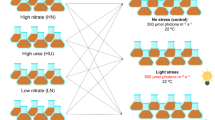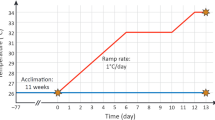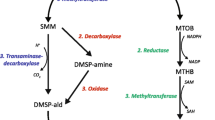Abstract
Dinoflagellate algae of the genus Symbiodinium occur as endosymbionts in a variety of hosts including coral. The response of Symbiodinium spp. to environmental changes could dictate survival of their hosts and the ecological success of coral reef ecosystems. Oxidative stress has been linked to a breakdown in this symbiotic relationship, known as bleaching. Increased temperature is one of the primary environmental changes linked to this phenomenon. Preliminary studies have established high concentrations of the sulfur compound dimethylsulfoniopropionate (DMSP) in Symbiodinium spp., with increased temperature. To examine the potential use of DMSP as an antioxidant, a 5 day incubation experiment was conducted at two temperatures with the algae S. microadriaticum (CCMP1633) isolated from the cnidarian host Aiptasia pulchella. An HPLC assay for the activity of the enzyme B12-dependent methionine synthase was modified and used to determine the link between de novo production of methionine, a precursor to DMSP, and temperature induced oxidative stress. DMSP concentrations per cell increased approximately 38 % in the 33 °C treatment cultures over 120 h. However, these cells also increased more than 2-fold in biovolume (127 ± 43 %), and SYTO-BC stain indicated increased DNA content (approximately 4-fold), suggesting arrested cell division. Normalization of DMSP to biovolume revealed that the concentrations actually decreased approximately 49 % after 2 days in cultures exposed to elevated temperature (33 °C), but were not significantly different from the control treatment at 120 h (27 °C). Concomitant changes in the 33 °C treatment relative to the control (after 120 h) resulted in an approximately 8-fold increase in reactive oxygen species, a 37 % (±7 %) decrease in photosynthetic efficiency of photosystem II, and a 5-fold increase in xanthophyll cycling. Methionine synthase activity (MSA) correlated to the decrease in DMSP concentration (R 2 = 0.778), with decreasing activity at the high temperature. Given this decrease in MSA, the increase in DMSP per cell may be due to DMSP production utilizing methionine from protein turnover, and not de novo synthesis via MSA. The findings of this study provide insight into the responses of algal symbionts to environmental changes, shed light on the potential use of DMSP and other known photo-protective mechanisms such as xanthophyll cycling under temperature induced oxidative stress, and support the suspected cessation of cell division under these conditions. This information could be crucial to understanding cellular responses to environmental changes and the ability of these organisms to survive under elevated sea surface temperatures projected for the near future.





Similar content being viewed by others
References
Banerjee RV, Harder SR, Ragsdale SW, Matthews RG (1990) Mechanism of reductive activation of cobalamin-dependent methionine synthase: an electron paramagnetic resonance spectroelectrochemical study. Biochemistry 29(5):1129–1135
Bouchard J, Yamasaki H (2008) Heat stress stimulates nitric oxide production in Symbiodinium microadriaticum: a possible linkage between nitric oxide and the coral bleaching phenomenon. Plant Cell Physiol 49(4):641–652
Buma A, Zemmelink H, Sjolemma K, Gieskes W (1996) UVB radiation modifies protein and photosynthetic pigment content, volume and ultrastructure of marine diatoms. Mar Ecol Prog Ser 142:47–54
Carlos AA, Bailey BK, Maruyama T (2000) Diversity of dinoflagellate symbionts (zooxanthellae) in a host individual. Mar Ecol Prog Ser 195:93–100
Charlson RJ, Lovelock JE, Andreae MO, Warren SG (1987) Oceanic phytoplankton, atmospheric sulphur, cloud albedo and climate. Nature 326:655–661
Chin M, Jacob DJ, Gardner GM, Foreman-Fowler, Spiro PS, Savoie DL (1996) A global three-dimensional model of tropospheric sulfate. J Geophys Res 101(D13):18667–18690
Coles SL, Jokiel PL, Lewis CR (1976) Thermal tolerance in tropical versus subtropical Pacific reef corals. Pac Sci 30:156–166
Cook CB, D’Elia CF, Muller-Parker G (1988) Host feeding and nutrient sufficiency for zooxanthellae in the sea anemone Aiptasia pallida. Mar Biol 98(2):253–262
Cooke RJ, Oliver J, Davies DD (1979) Stress and protein turnover in Lemna minor. Plant Physiol 64(6):1109–1113
Danishpajooh IO, Gudi TC, Yongchang K, Vladimir G, Sharma VS, Boss GR (2001) Nitric oxide inhibits methionine synthase activity in vivo and disrupts carbon flow through the folate pathway. J Biol Chem 276(29):27296–27303
DiTullio GR, Geesey ME (2002) Photosynthetic pigments in marine algae and bacteria. In: Bitton G (ed) The Encyclopedia of Environmental Microbiology. John Wiley & Sons Inc., New York, pp 2453–2470
DiTullio GR, Smith WO (1995) Relationship between dimethylsulfide and phytoplankton pigment concentrations in the Ross Sea, Antarctic. Deep-Sea Res I 42:873–892
Dunn SR, Thomason JC, Le Tissier MDA, Bythell JC (2004) Heat stress induces different forms of cell death in sea anemones and their endosymbiotic algae depending on temperature and duration. Cell Death Differ 11(11):1213–1222
Dykens JA, Shick JM (1982) Oxygen production by endosymbiotic algae controls superoxide dismutase activity in their animal host. Nature 297(5867):579–580
Evans C, Malin G, Mills G (2006) Viral infection of Emiliania huxleyi (Prymneiophyceae) leads to elevated production of reactive oxygen species. J Phycol 42:1040–1047
Fiskerstrand T, Uel PM, Refsum H (1997) Folate depletion induced by methotrexate affects methionine synthase activity and its susceptibility to inactivation by nitrous oxide. J Pharmacol Exp Ther 282(3):1305–1311
Franklin DJ, Hoegh-Guldberg O, Jones RJ, Berges JA (2004) Cell death and degeneration in the symbiotic dinoflagellates of the coral Stylophora pistillata during bleaching. Mar Ecol Prog Ser 272:117–130
Fridovich I (1995) Superoxide radical and superoxide dismutases. Annu Rev Biochem 64:97–112
Gage DA, Rhodes D, Nolte KD, Hicks WA, Leustek T, Cooper AJL, Hanson A (1997) A new route for synthesis of dimethylsulphoniopropionate in marine algae. Nature 387:891–894
Gala WR, Giesy JP (1990) Flow cytometric techniques to assess toxicity to algae. Aquatic toxicology and risk assessment. American Society for Testing and Materials, Philadelphia, pp 237–246
Gatti R, Belletti S, Orlandini G, Bussolati O, Dall’Asta V, Gazzola GC (1998) Comparison of annexin V and calcein-AM as early vital markers of apoptosis in adherent cells by confocal laser microscopy. J Histochem Cytochem 46:895–900
Goreau TJ, Hayes RL (1994) Coral bleaching and ocean “hot spots”. Ambio 23:176–180
Goss R, Mewes H, Wilhelm C (1999) Stimulation of the diadinoxanthin cycle by UV-B radiation in the diatom Phaeodactylum tricornutum. Photosynth Res 59(1):73–80
Greene RC (1962) Biosynthesis of dimethyl–propiothetin. J Biol Chem 237:2251–2254
Gröne T, Kirst GO (1992) The effect of nitrogen deficiency, methionine and inhibitors of methionine metabolism on the DMSP contents of Tetraselmis subcordiformis (Stein). Mar Biol 112:497–503
Hoegh-Guldberg O (1999) Climate change, coral bleaching, and the future of the world’s coral reefs. Mar Freshw Res 50:839–866
Huang L, Zhang J, Hayakawa T, Tsuge H (2001) Assays of methylenetetrahydrofolate reductase and methionine synthase activities by monitoring 5-methyltetrahydrofolate and tetrahydrofolate using high-performance liquid chromatography with fluorescence detection. Anal Biochem 299:253–259
Hughes TP, Baird AH, Bellwood DR, Card M, Connolly SR, Folke C, Grosberg R, Hoegh-Guldberg O, Jackson JBC, Kleypas J, Lough JM, Marshall P, Nystrom M, Palumbi SR, Pandolfi JM, Rosen B, Roughgarden J (2003) Climate change, human impacts, and the resilience of coral reefs. Science 301(5635):929–933 Review
Jokiel PL, Brown EK (2004) Global warming, regional trends and inshore environmental conditions influence coral bleaching in Hawaii. Global Change Biol 10:1641–1727
Jones GB, Trevena A (2005) The influence of coral reefs on atmospheric dimethylsulphide over the Great Barrier Reef, Coral Sea, Gulf of Papua and Solomon and Bismarck Seas. Mar Freshw Res 56:86–93
Jones RJ, Hoegh-Guldberg O, Larkum AWD, Schreiber U (1998) Temperature-induced bleaching of corals begins with impairment of the CO2 fixation mechanism in zooxanthellae. Plant, Cell Environ 21:1219–1230
Jones G, Curran M, Broadbent A, King S, Fischer E, Jones R (2007) Factors affecting the cycling of dimethylsulfide and dimethylsulfoniopropionate in coral reef waters of the Great Barrier Reef. Environ Chem 4(5):310–322
Karako-Lampert S, Katcoff DJ, Achituv Y, Dubinsky Z, Stambler N (2005) Responses of Symbiodinium microadriaticum clade B to different environmental conditions. J Exp Mar Biol Ecol 318(1):11–20
Keller MD, Selvin RC, Claus W, Guillard RRL (1987) Media for the culture of oceanic ultraphytoplankton. J Phycol 23:633–638
Kiene RP, Slezak D (2006) Low dissolved DMSP concentrations in seawater revealed by small-volume gravity filtration and dialysis sampling. Limnol Oceanogr Methods 4:80–95
Lesser MP, Stochaj WR, Tapley DW, Shick JM (1990) Bleaching in coral reef anthozoans: effects of irradiance, ultraviolet radiation, and temperature on the activities of protective enzymes against active oxygen. Coral Reefs 8:225–232
Lilley RM, Ralph PJ, Larkum AWD (2010) The determination of activity of the enzyme Rubisco in cell extracts of the dinoflagellate alga Symbiodinium sp. by manganese chemiluminescence and its response to short-term thermal stress of the alga. Plant, Cell Environ 33(6):995–1004
Matrai PA, Vernet M, Hood R, Jennings A, Brody E, Saemundsdóttir S (1995) Light dependence of carbon and sulfur production by polar clones of the genus Phaeocystis. Mar Biol 124:157–167
McLenon AL (2010) Effects of increased temperature and CO2 on dimethylsulfoniopropionate (DMSP) concentration in Symbiodinium microadriaticum and associated changes in methionine synthase activity. Masters Thesis, College of Charleston, Charleston, SC, pp. 1–114
Miller JR (2009) Effects of Temperature on Dimethylsulfoniopropionate Concentration in Symbiodinium (Freudenthal, 1962). Masters Thesis, College of Charleston, Charleston SC, pp. 1–86
Mostajir BS-N, Demers S (1999) Ecological implications of changes in cell size and photosynthetic capacity of marine Prymnesiophyceae induced by ultraviolet-B radiation. Mar Ecol Prog Ser 187:89–100
Perez S, Weis V (2006) Nitric oxide and cnidarian bleaching: an eviction notice mediates breakdown of a symbiosis. J Exp Biol 209(14):2804–2810
Santos SR, Taylor DJ, Coffroth MA (2001) Genetic comparisons of freshly isolated versus cultured symbiotic dinoflagellates: implications for extrapolating to the intact symbiosis. J Phycol 37:900–912
Stefels J (2000) Physiological aspects of the production and conversion of DMSP in marine algae and higher plants. J Sea Res 43:183–197
Stochaj WR, Grossman AR (1997) Differences in the protein profiles of cultured and endosymbiotic Symbiodinium sp. (Pyrrophyta) from the anemone Aiptasia Pallida (Anthozoa). J Phycol 33(1):44–53
Sunda W, Kieber DJ, Kiene RP, Huntsman S (2002) An antioxidant function for DMSP and DMS in marine algae. Nature 418:317–320
Tchernov D, Gorbunov MY, de Vargas C, Yadav SN, Milligan AJ, Haggblom M, Falkowski PG (2004) Membrane lipids of symbiotic algae are diagnostic of sensitivity to thermal bleaching in coral. Proc Nat Acad Sci 101(37):13531–13535
Trossat C, Rathinasabapathi B, Weretilnyk EA, Shen T-L, Huang Z-H, Gage DA, Hanson AD (1998) Salinity promotes accumulation of 3-dimethylsulfoniopropionate and its precursor S-methylmethionine in chloroplasts. Plant Physiol 116(1):165–170
Uggeri J, Gatti R, Belletti S, Scandroglio R, Corradini R, Rotoli BM, Orlandini G (2000) Calcein-AM is a detector of intracellular oxidative activity. Histochem Cell Biol 122(5):499–505
Van Alsytne K, Dominique VJ, Muller-Parker G (2009) Is dimethylsulfoniopropionate (DMSP) produced by the symbionts or the host in an anemone-zooxanthella symbiosis? Coral Reefs 28(1):167–176
Wang LH, Liu YH, Ju YM, Hsiao YY, Fang LS, Chen CS (2008) Cell cycle propagation is driven by light-dark stimulation in a cultured symbiotic dinoflagellate isolated from corals. Coral Reefs 27(4):823–835
Wellington GM, Glynn PW, Strong AE et al (2001) Crisis on coral reefs linked to climate change. EOS 82:1–7
White RH (1982) Analysis of dimethyl sulfonium compounds in marine algae. J Mar Res 40(2):529–536
Yost DM, Mitchelmore CL (2009) Dimethylsulfoniopropionate (DMSP) lyase activity in different strains of the symbiotic alga Symbiodinium microadriaticum. Mar Ecol Prog Ser 386:61–70
Yost DMJ, Ross J, Mitchelmore CL (2010) Alterations in dimethylsulfoniopropionate (DMSP) levels in the coral Montastraea franksi in response to copper exposure. Aquat Toxicol 98(4):367–373
Zapata M, Rodriguez F, Garrido JL (2000) Separation of chlorophylls and carotenoids from marine phytoplankton: a new HPLC method using a reversed phase C8 column and pyridine-containing mobile phases. Mar Ecol Prog Ser 195:29–45
Acknowledgments
This research was conducted at Hollings Marine Laboratory, Charleston, SC, and was funded by various National Science Foundation/Ocean Sciences grants (Dr. Giacomo DiTullio: OCE-0728683, OCE-0338097, NSF-ANT-0739597, and Dr. Mike Janech : NSF-ANT-0739446). We are extremely appreciative of Dr. Michael Janech for his integral role in this research. We express gratitude to Dr. Peter Moeller for the use of his facilities, to Kevin Huncik for technical assistance, and to Jennifer Bennett, Dr. Peter Lee, Tyler Cyronak, Barbara Lyon, Juliana Miller, Sarah Riseman, and Dr. Erik Sotka for their comments and suggestions. This contribution represents No. 384 to the Grice Marine Laboratory, Charleston, SC.
Author information
Authors and Affiliations
Corresponding author
Rights and permissions
About this article
Cite this article
McLenon, A.L., DiTullio, G.R. Effects of increased temperature on dimethylsulfoniopropionate (DMSP) concentration and methionine synthase activity in Symbiodinium microadriaticum . Biogeochemistry 110, 17–29 (2012). https://doi.org/10.1007/s10533-012-9733-0
Received:
Accepted:
Published:
Issue Date:
DOI: https://doi.org/10.1007/s10533-012-9733-0




